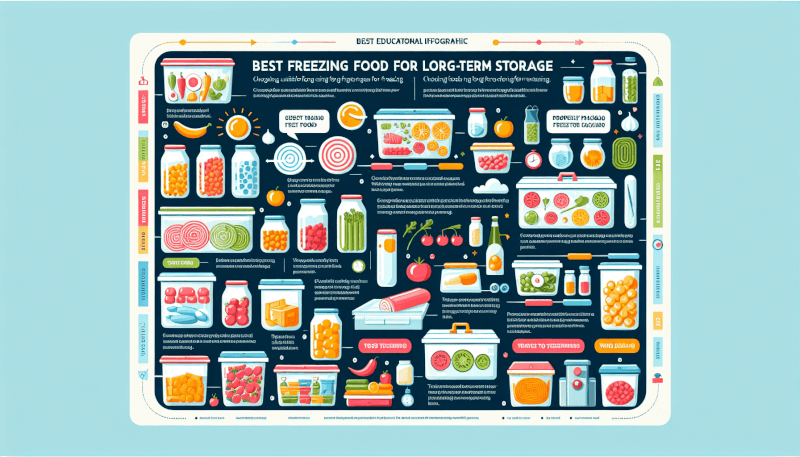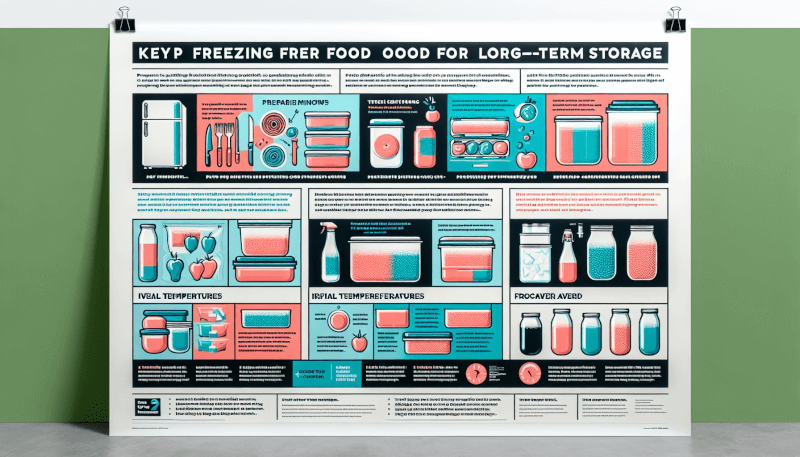Are you tired of food going bad before you have a chance to enjoy it? If so, you’re in luck! In this article, you will discover the best methods for freezing food to ensure it stays fresh and delicious for long-term storage. Whether you’re an amateur cook or a seasoned chef, these tips will help you make the most of your freezer space and save money by reducing food waste. Get ready to learn the secrets to preserving your favorite meals and ingredients with ease!

Choosing the Right Containers
When it comes to storing food in the freezer, choosing the right containers is essential to maintain the quality and freshness of your frozen goods. Plastic containers, glass containers, and freezer bags are all popular options, each with their own advantages and disadvantages.
Plastic Containers
Plastic containers are lightweight and convenient for freezing food. They come in various sizes and shapes, making it easy to find the perfect container for your needs. Plastic containers are also stackable, allowing you to maximize the space in your freezer. However, it is important to choose BPA-free containers to ensure that no harmful chemicals leach into your food.
Glass Containers
Glass containers are a great eco-friendly and versatile alternative to plastic containers. They are free from any chemicals and can be safely used in the microwave or oven. Glass containers are also transparent, which allows you to easily see the contents of each container without having to open it. However, they tend to be heavier and more fragile compared to plastic containers.
Freezer Bags
Freezer bags are a convenient and space-saving option for freezing food. They are particularly suitable for liquids and soups since the bags can be laid flat in the freezer, saving precious space. Freezer bags are also flexible, making it easy to squeeze out excess air before sealing them. However, they are not as durable as containers and can tear if not handled with care.
Preparing Food for Freezing
Properly preparing your food before freezing is crucial to maintain its quality and taste. Here are some important steps to follow when preparing food for freezing.
Selecting Fresh Ingredients
When it comes to freezing food, it is essential to start with fresh and high-quality ingredients. Choose fruits and vegetables that are ripe but not overripe, as overripe produce may not freeze as well. Similarly, select meats and dairy products that are fresh and have not reached their expiration date.
Cleaning and Preparing the Food
Before freezing, it is important to properly clean and prepare the food. Wash fruits and vegetables under running water to remove any dirt or pesticides. Trim off any bruised or damaged portions and remove unwanted peels or skins. For meat, trim excess fat and remove bones if necessary.
Cutting and Slicing Techniques
When freezing fruits and vegetables, it is important to cut them into appropriate sizes for your desired use. While some fruits like berries can be frozen whole, others may need to be sliced or diced before freezing. Similarly, vegetables can be cut into bite-sized pieces or sliced depending on how you plan to use them later. Try to ensure uniformity in size to ensure even freezing and cooking.
Blanching Produce
Blanching is an essential step for certain fruits and vegetables before freezing. It involves briefly cooking the produce in boiling water and then rapidly cooling them in ice water. Here’s why blanching is important and how to do it correctly.
Why Blanching is Important
Blanching helps to preserve the color, texture, and nutritional value of fruits and vegetables by inactivating enzymes that can cause degradation. It also helps to remove any dirt or bacteria from the surface of the produce, ensuring food safety.
How to Blanch Fruits and Vegetables
To blanch fruits and vegetables, start by bringing a pot of water to a rolling boil. Place the produce in a wire basket or strainer and lower it into the boiling water. The blanching time will vary depending on the type of produce, so refer to a blanching chart for specific guidelines. After blanching, quickly transfer the produce to a bowl of ice water to cool and stop the cooking process. Once cooled, drain the produce thoroughly before packing it for freezing.
Packaging Techniques
Proper packaging is key to prevent freezer burn, maintain food quality, and prevent cross-contamination in the freezer. Here are some important packaging techniques to consider when freezing food.
Removing Excess Air
When packaging food for freezing, it is crucial to remove as much air as possible from the container or bag. Excess air can cause freezer burn and deteriorate the quality of the food. Use vacuum sealers or press out as much air as possible from plastic containers or freezer bags before sealing them.
Using Freezer-Safe Wraps
If you plan to store food for an extended period, it is recommended to wrap it with a layer of freezer-safe wrap to provide an extra layer of protection. Aluminum foil or plastic wrap designed for freezing can help prevent moisture loss and freezer burn.
Labeling the Packages
To stay organized and easily identify your frozen foods, it is important to label each package with the contents and date of freezing. This will help you keep track of the shelf life of each item and ensure that you use them within a reasonable timeframe.

Freezing Fruits
Freezing fruits is a great way to preserve their freshness and enjoy them throughout the year. Whether you have whole fruits or sliced fruits, here are some methods for freezing fruits.
Whole Fruits
Some fruits can be frozen whole, making it easy to enjoy them as a refreshing snack or use them in smoothies or desserts. Examples of fruits that can be frozen whole include berries, grapes, and cherries. Simply wash the fruits, remove any stems or leaves, and place them in a single layer on a baking sheet. Once frozen, transfer them to a freezer bag or container.
Sliced Fruits
For fruits like peaches, mangoes, or pineapples, it is best to slice them before freezing. Peel and slice the fruits into desired shapes and sizes. Lay the slices on a baking sheet lined with parchment paper and freeze them until solid. Transfer the frozen slices to a freezer bag or container for long-term storage.
Sugar-Pack Method
The sugar-pack method is ideal for fruits like strawberries, raspberries, or peaches, as it helps to preserve their flavor and texture. Toss the washed and sliced fruits with sugar (usually about 1/2 to 1 cup of sugar per 4 cups of fruit) until well coated. Allow the mixture to sit for about 15 minutes until the sugar dissolves and creates a syrup. Transfer the fruit and syrup into containers or freezer bags, taking care to remove any excess air.
Freezing Vegetables
With proper freezing techniques, you can preserve the taste and nutritional value of vegetables for future use. Here are some methods for freezing vegetables.
Blanched Vegetables
Blanching is particularly important for vegetables before freezing to prevent enzyme activity and maintain their color, texture, and flavor. After blanching, drain the vegetables thoroughly and transfer them to a baking sheet in a single layer to freeze. Once frozen, transfer them to airtight containers or freezer bags.
Raw Vegetables
While blanching is recommended for most vegetables, some vegetables can be frozen raw. Examples of vegetables that can be frozen without blanching include peppers, onions, and celery. Simply wash, peel (if necessary), and chop the vegetables into desired sizes. Place them in a freezer bag or container, ensuring to remove as much excess air as possible.
Pureeing Vegetables
Pureeing vegetables before freezing is an excellent idea if you plan on using them for soups, sauces, or baby food. Cook the vegetables until tender and allow them to cool. Puree them in a blender or food processor until smooth, then transfer the puree into freezer-safe containers or ice cube trays for portioning. Once frozen, transfer the portions into a freezer bag for easy access.

Freezing Meat
Properly freezing meat is essential to maintain its quality and ensure its safety for consumption. Here are some tips for freezing different types of meat.
Wrap and Seal Properly
To prevent freezer burn and maintain the quality of meat, it is important to wrap it tightly and seal it properly. For individual cuts of meat, wrap them tightly with plastic wrap or use a vacuum sealer to remove excess air. Place the wrapped cuts in a freezer bag or container, ensuring a tight seal. For larger cuts of meat, consider dividing them into smaller portions for easier access.
Portioning for Easy Access
When freezing meat, it is helpful to portion it according to your needs. Divide larger cuts into smaller portions that can be easily thawed and used for meals. This way, you can avoid thawing more meat than necessary and reduce the risk of food waste.
Making Ground Meat Patties
If you frequently use ground meat, consider shaping them into patties before freezing. Divide the ground meat into desired portions and shape them into patties. Place parchment paper between each patty to prevent sticking. Once shaped, stack the patties in an airtight container or wrap them individually with plastic wrap. This makes it convenient to grab the desired number of patties without having to thaw the entire package.
Freezing Dairy Products
Many dairy products can be successfully frozen for future use. Here are some guidelines for freezing common dairy products.
Cheese
Hard and semi-soft cheeses can be successfully frozen for grating or melting purposes. Cut the cheese into smaller portions and wrap them tightly in plastic wrap or aluminum foil. Place the wrapped portions in a freezer bag or container. Soft cheeses like cream cheese or goat cheese may become crumbly or lose their creamy texture after freezing, so it is best to use them for cooked dishes rather than for spreading.
Milk and Cream
Freezing milk or cream is possible, but it may result in a slight change in texture and consistency. Pour the milk or cream into a freezer-safe container, leaving some headspace for expansion. Thawed milk or cream may separate, so shake it well before using it. It is important to note that frozen milk is best used in cooking or baking rather than for drinking.
Butter
Butter can be easily frozen for long-term storage. Wrap the butter tightly in plastic wrap or aluminum foil to prevent it from absorbing any odors or flavors in the freezer. Place it in a freezer bag or container for extra protection. Frozen butter can be used directly from the freezer for cooking or baking.

Freezing Baked Goods
Baking in batches and freezing the extras is a great way to have homemade treats ready whenever the craving strikes. Here are some tips for freezing different types of baked goods.
Breads and Rolls
Most breads and rolls freeze well and can be enjoyed later without compromising their taste and texture. Allow the bread or rolls to cool completely before freezing. Wrap them tightly in aluminum foil or plastic wrap to prevent moisture loss. Place the wrapped bread or rolls in a freezer bag or container. To thaw, simply leave them at room temperature or heat them in the oven for a few minutes.
Cakes and Cupcakes
Cakes and cupcakes can also be successfully frozen, but it is crucial to remove any frosting or icing before freezing. Wrap the unfrosted cakes or cupcakes tightly with plastic wrap or aluminum foil. Place them in a freezer bag or container, taking care not to squish or damage them. Thaw them overnight in the refrigerator before adding frosting or serving.
Cookies and Brownies
Cookies and brownies are best frozen individually, so you can easily grab a treat whenever you want. Allow the cookies or brownies to cool completely before freezing. Place them in a single layer on a baking sheet and freeze until solid. Once frozen, transfer them to a freezer bag or container, placing parchment paper between layers if stacking. Thaw them at room temperature for a few minutes before enjoying.
Thawing and Using Frozen Food
Knowing the proper thawing methods and cooking techniques for frozen food is important to maintain food safety and quality. Here are some guidelines for thawing and using frozen food effectively.
Thawing Methods
The ideal way to thaw frozen food is by transferring it from the freezer to the refrigerator and allowing it to thaw slowly overnight. This method ensures a gradual thaw and minimizes the risk of bacterial growth. For smaller portions or when time is limited, you can also thaw frozen food under cold running water or using the defrost function on your microwave. It is important to avoid thawing food at room temperature, as this can lead to bacterial growth.
Cooking Frozen Food
Cooking frozen food requires some adjustments to ensure proper cooking and prevent foodborne illnesses. Follow the cooking instructions provided on the packaging or recipe, but be prepared to increase the cooking time slightly for frozen food. Use a food thermometer to ensure that the internal temperature reaches the recommended safe zone.
Understanding Shelf Life
Frozen food can be safely stored for an extended period, but it is important to understand the shelf life of different types of food. While frozen fruits and vegetables can maintain their quality for up to 12 months, meats and dairy products are best consumed within 3 to 6 months. Baked goods like breads and rolls can be stored for up to 3 months, while cakes, cupcakes, cookies, and brownies are best within 1 to 2 months. Regularly check the quality of frozen food and discard any items that show signs of freezer burn or degradation.
By following these tips and techniques for freezing food, you can ensure that your frozen goods maintain their quality and flavor for long-term storage. Whether you’re freezing fruits, vegetables, meat, dairy products, or baked goods, proper preparation, packaging, and thawing methods are key to successful freezing and delicious meals down the line. Happy freezing!



